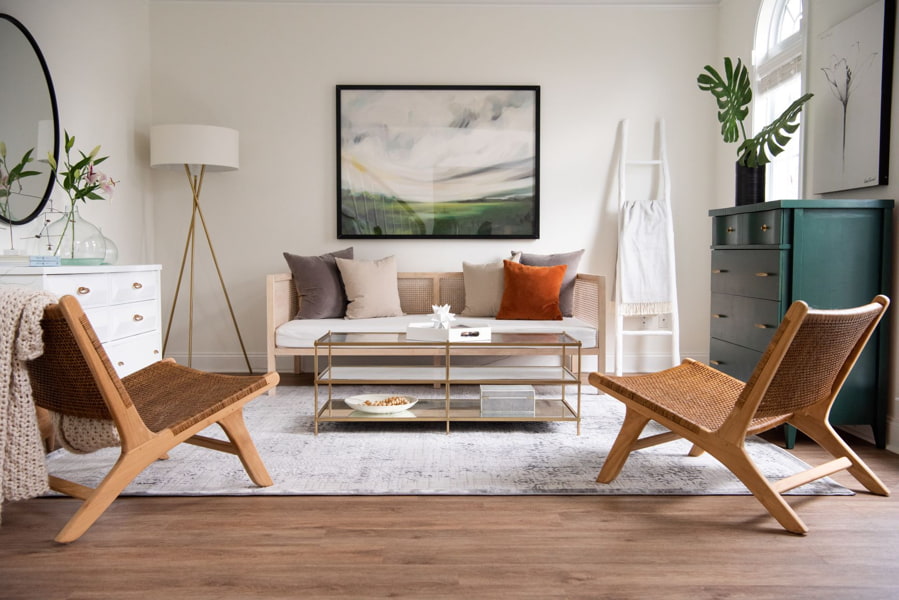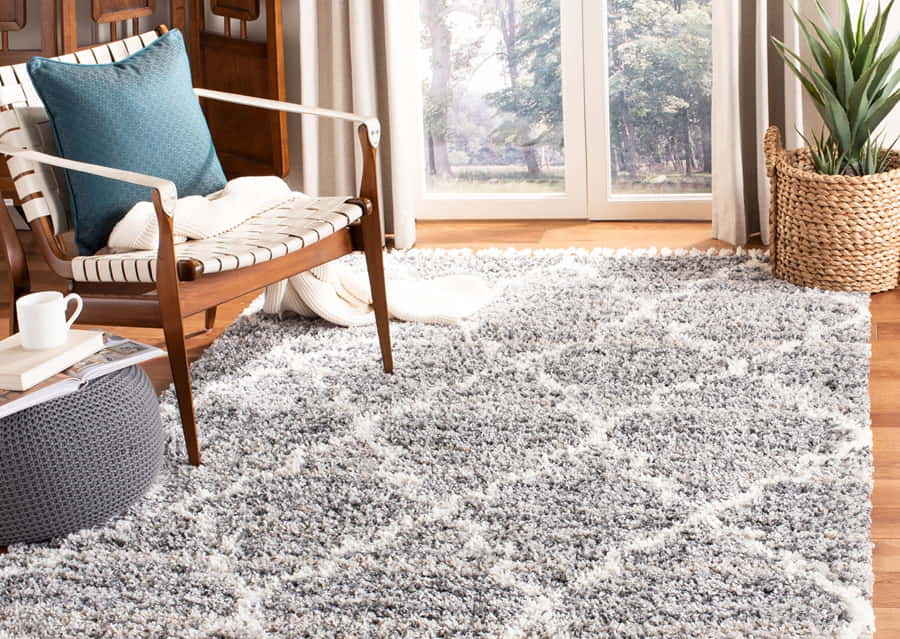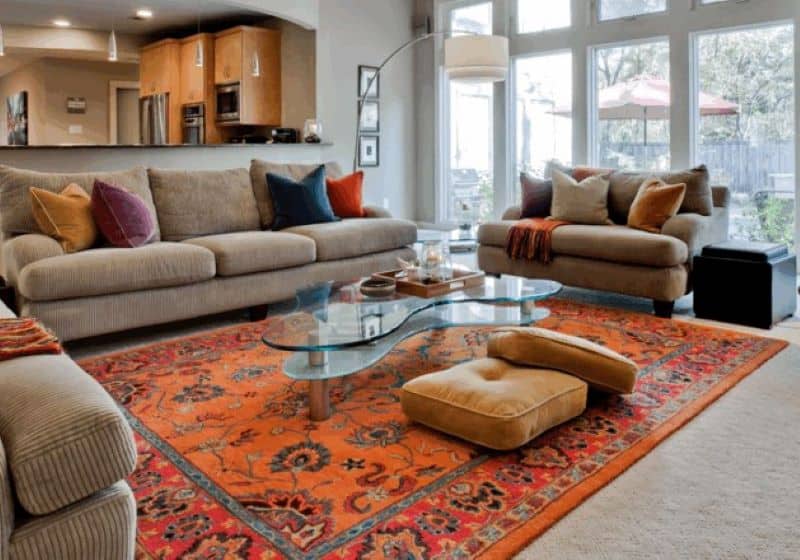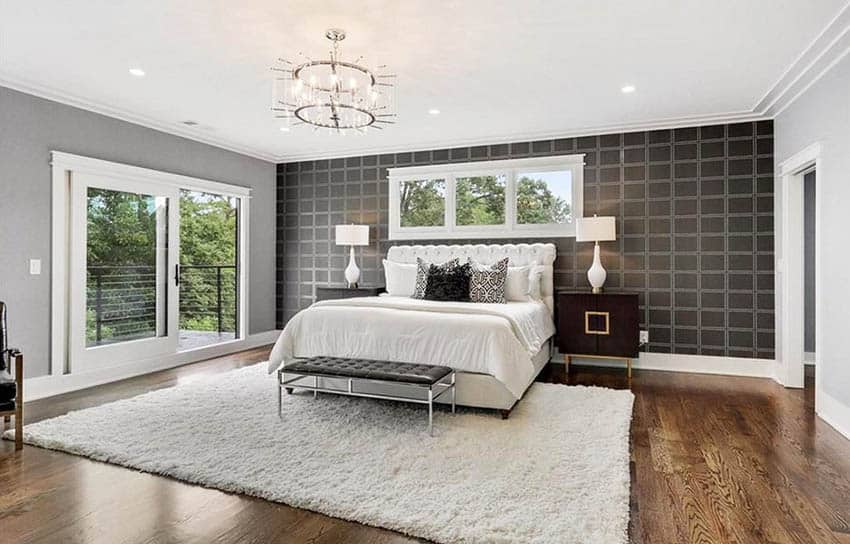Area rugs are effective design tools for those looking to give a touch of style and warmth to their living spaces. However, the question you be thinking of asking is, “Can you place an area rug over the carpet?
Rugs for the area are typically best with looped or short pile carpets. If you’re using any carpet types, what best thing could you do? Put an ultra-soft and fluffy shag rug over them to bring elegance and comfort to your space. Going with a Berber or weaved rug is recommended if you have an extra-soft carpet.
Learn practical ways to lay a carpet on top of the carpet and much more.

What Is an Area Rug?
Technically speaking, large-area rug sizes are from 8’7” to 12′. Medium-sized area rugs are in between 5’1” to 8’6”. Lastly, smaller area rugs typically measure smaller then 5′. Rugs for areas differ from carpets because they’re moveable and do not typically span from wall to wall. They also have more detailed and vibrant designs.

Are Area Rugs Essential?
Do you want to lay them on carpets? It’s all about preference. There are several convincing reasons for this:
- The carpet is beginning to show signs of wear and dullness.
- An affordable and easy method to add color, personality, or texture to your home.
- It covers unsightly stains and damage and stains that chemical cleaning products and steam cleaning won’t be able to repair.
- You do not like the carpet in the rental property you’re renting.
- It’s not financially feasible to buy a new carpet right now.
Tips for Laying an Area Rug Over Carpet
Although some people find it inappropriate, it shouldn’t discourage people from purchasing carpets for your area and placing them on them. There are a variety of ways and “rules” that are available. Let’s begin with the most basic methods of putting the rug over the carpet:

Vary the Texture
The texture could refer to various things. It could be a reference to the feelings that the rug’s structure creates. Sometimes, it can refer to the process of weaving, which includes:
- Knotted,
- Loops,
- Sheared,
- Woven, and so on.
Also, it can be the height of the pile of a rug.
- Larger and looser (High-pile) and
- More compact and shorter (Short-pile).

Create an Eye-catching Texture Through Layering
One of the most effective ways to create a stunning texture is layering. When layering, ensure that you use a variety of textures, particularly if you intend to overlay rugs on the carpet to give it more visual interest and complexity.
For instance, if you have a thick and soft carpet, choose a short-pile rug, like one called a Berber rug. You can also add a grainy jute rug or a silky rug on top for an ordinary carpet. It is also possible to combine wool rug and Jute rug.
Avoid Using a Thick Rug Over a Plush Rug
Do not put a heavy area rug on top of a soft carpet. It’s not good to place an area rug on top of carpets with high and soft fibers, like shag carpet (1/2 up in height to 3/8” high), since it’s bound to move and wrinkle.
Patterns Should Complement Each Other
The right patterns to choose from can be a challenge. If you are doing too much, it could smudge the style of your space. Therefore, here are some tips to consider while mixing and matching patterns, colors, and textures:

Go Neutral
A neutral-colored carpet can be paired with an area rug of neutral color. The neutral shades are cool and warm tones, such as brown, black and gray. They also include tan, gray, and white. Select this palette if you are not looking to put up an eye-catching rug in your living space or looking for a room that isn’t cluttered or distracting.
Mix in Solid Colors
Avoid using a rug with a pattern over a rug with a pattern, as it won’t look nice. Instead, combine your patterned carpet and an unpatterned area rug with the same color or does not have any pattern whatsoever.
Use a Different Pattern Scale
You may be able to make do with an area rug with basic patterns when you put it on a flat, plain broadloom carpet. However, if you wish to create two different patterned area carpets, make sure that the patterns are different in size and dimensions.
As an example, you can choose an area rug with simple and subtle patterns to match your carpet. Then, choose more bold and striking designs. Finally, be sure to select the same color.
Always Match the Color of Your Carpet
It’s tempting to ignore this step. However, it would help if you didn’t lay on a rug that contrasts with the colors of your rug. It’s sure to break the harmony and aesthetics of your living space.

Be cautious when selecting rugs that have high-contrast colors.
If your carpet is of a unicolored color and pattern, you’ll be able to play around with area rugs in different hues. If the rug you’re interested in is a solid color or a simple pattern, choose the opposite. Take care that you don’t pick rugs with high-contrast colors or too many patterns or shades.
Choose Neutral Colors for Beach-themed Rooms
Pick a rug with a lighter color to make the room appear larger, even if it’s smaller. Neutral colors, like beige or gray and white, are ideal for spaces with a beach theme.

Pick Area Rugs that have Cool Colors to create a Peaceful Ambience
Pick area rugs with cool hues like blue-purple, green, and blue to create a tranquil space. Use vibrant area rugs that make you feel more cheerful.
Is it okay to place a rug on the carpet? It is recommended to place rug area rugs on a looped or short-pile carpet. A thick and luxurious shag rug makes your living space look elegant. If you have a luxurious carpet design, it is recommended to include a Berber or a woven rug.
Size and Shape Matter
Visualize Using Painter’s Tape
The area rug you choose should be the correct size for the space. Otherwise, it’s likely to appear unnatural and unprofessional. Suppose you’re struggling to visualize the space or carpet using the area rug, use painter’s tape. First, place the tape over the area you’ll use to place your rug. Then, place furniture in the area in the area.
Factors to Consider When Choosing the Area Rugs’ Size and Shape
There are three aspects you should think about when choosing the dimensions and shapes of your area rug:
- Dimension of your wall-to-wall carpet
- Furniture arrangement
- The size and shape of the space where you’ll place them

How to Determine the Carpet’s Size for a Rectangular and Irregular Room
To calculate the size of the carpet, you are using the only thing you have simply to multiply the width and length of the room to calculate what the area is. For instance, if the space is 12 feet by 18 feet, the square footage will be 221.
If the room doesn’t have a standard and rectangular plan or has an irregular form, then follow these steps:
- Determine the locations where you’d like to put your wall-to-wall carpet and your area rug: Make a note of the number of rooms you want to carpet. Are there any additional connecting spaces?
- Find the room’s dimensions (square feet), the hallway, doors, and closets. The room has unorthodox layouts, so you can divide them into rectangular squares (or rectangles, depending on what you like).
- Make sure to measure each square, and then add them all together. For a simpler process, it’s best to Round inches up to the nearest foot. So when you’re given an amount of 13.7, just increase it to 14.
- Note that if the room has an “L” design, measure it as two distinct rooms.
- Repeat the step before for the other walls until you achieve the desired width.
- Increase the length by a few inches after the measurements; add a few inches (or at minimum 10% for trimming) to the carpet pieces you’ll require. This will allow you to have some room for mistakes.
Anchor Your Area Rugs
One of the main concerns of placing an area over a carpet is the chance of falling, slipping, and wrinkles. So, in addition to the color texture, style, and design, it is essential to make sure that the area rug doesn’t turn into a safety danger.
Why Does an Area Rug Shift on a Carpet?
The reason carpets tend to bunch up and move around on carpets is because they generally follow the movement of the carpet’s pile after the impact of your feet. Since most carpet piles move towards an area near the principal entrance, your rug is also moving in the direction you are walking across it.

How to Secure an Area Rug on Top of Carpet
Here are the best methods to fix an area rug over a carpet without damaging one of them:
Rug Pads
Purchase “carpet-to-carpet” pads designed to prevent the area rug from shifting or wrinkled when placed over a carpet. The rug’s surface pad is made from felt, which is attached to your carpet fibers. In addition, the bottom of the pad is constructed from natural rubber that helps hold it in the right place.
Double-Sided Carpet Tape
A double-sided carpet tape operates like a regular double-sided tape. Its only difference is that it’s more durable and stickier.
The most commonly used kinds of double-sided carpet tapes are composed of adhesives, such as glue, rubber, and silicone. They are made of silicone, which is considered the best as they are stronger, do not leave any sticky residues, and are less likely to cause damage to carpet or flooring. However, the downside is that the glue will be worn down over a long period.

If you are buying carpet tape with a double-sided backing, check the tensile force. A normal carpet tape that has a tensile force of 25 pounds/square inch is typically enough to hold the carpets and rug in its place.
Use Furniture as a Rug Anchor
Pick a sturdy furniture piece to anchor the area rug on four or two sides. It may be your sofa or chair or sofa. Make sure not to obscure your rug’s stunning designs and colors. Instead of large furniture for the living room, perhaps you can use pieces of furniture that have small wide, long, and narrow dimensions, like a table for a sofa or the footrest. So your rug remains in place and is it is visible.
Mix Multiple Area Rugs
A reason is that some people are reluctant to combine several rugs in the same area of their house. However, it is not a rule prohibiting having more than one rug, especially when you put an area rug over the carpet.
It is your choice to blend and mix various rug designs. Your space is yours!

How Do You Know If You Should Use One or More Area Rugs in a Room?
For designers, the most important aspect is the space. Choose an area rug only for smaller spaces between doors and walls
Use Complementary Area Rugs
A different option would be to pair the wall-to-wall carpets with other carpets. If done properly, this can be a great method to enhance the scheme of color or to introduce some color to a space.

You can keep it simple. For example, you could mix two or more area rug designs with solid shades. Also, you could select area rugs that have distinct patterns but of identical color.
Keep in mind that the patterns should visually complement each other.
Layer Them
Layering is a risky concept, but it does be effective. Designers have been using this technique for a long time, particularly when working in a space with enough space and minimal furniture.

Place Two Area Rugs on Top of Each Other
It is possible to arrange two area rugs for each other with the bigger and non-patterned area rug laid on top of the smaller and more attractive area rug. You can also place the rugs in layers based on their weave and material. For example, you can put a sisal rug in the middle of a stunning flat-woven rug, like Dhurries and Kilim rug.
Be Careful Not to Overdo It
The most important thing is to build the pile excessively high, making it an eye-sore and a trip risk. If you can, you can keep it to 3 layers.
Conclusion – Rug on Top of Carpet
It’s not uncool or unfashionable to put a rug on a carpet. Carpets and area rugs can work together, so they share something that they share: design, color, or design. Take the advice I’ve provided you to assist you in choosing the ideal rug for your area to add to your carpet.

